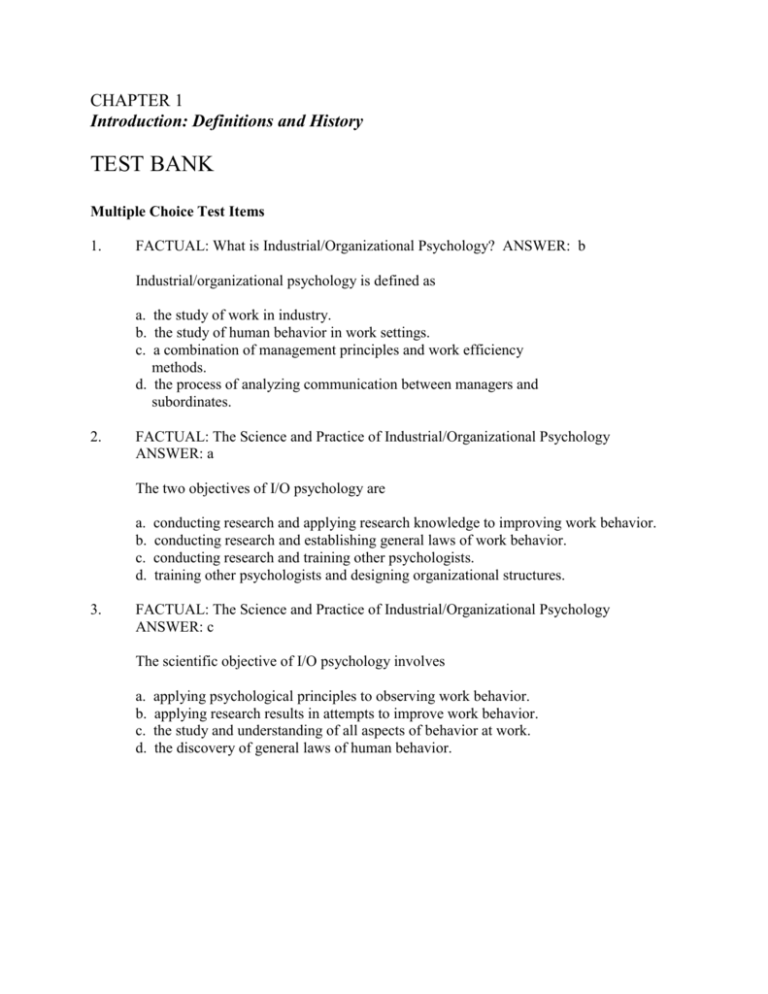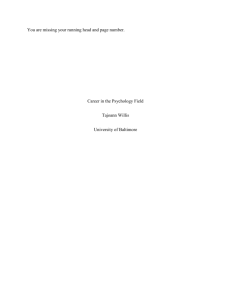sample - TestbankHub.Com
advertisement

CHAPTER 1 Introduction: Definitions and History TEST BANK Multiple Choice Test Items 1. FACTUAL: What is Industrial/Organizational Psychology? ANSWER: b Industrial/organizational psychology is defined as a. the study of work in industry. b. the study of human behavior in work settings. c. a combination of management principles and work efficiency methods. d. the process of analyzing communication between managers and subordinates. 2. FACTUAL: The Science and Practice of Industrial/Organizational Psychology ANSWER: a The two objectives of I/O psychology are a. b. c. d. 3. conducting research and applying research knowledge to improving work behavior. conducting research and establishing general laws of work behavior. conducting research and training other psychologists. training other psychologists and designing organizational structures. FACTUAL: The Science and Practice of Industrial/Organizational Psychology ANSWER: c The scientific objective of I/O psychology involves a. b. c. d. applying psychological principles to observing work behavior. applying research results in attempts to improve work behavior. the study and understanding of all aspects of behavior at work. the discovery of general laws of human behavior. 4. FACTUAL: The Science and Practice of Industrial/Organizational Psychology ANSWER: b The applied objective of I/O psychology involves a. b. c. d. 5. examining and describing human work behavior. the application of psychological principles to work behavior. the discovery of general laws of human behavior. conducting research and publishing it in scientific journals. FACTUAL: The Roots and Early History of Industrial/Organizational Psychology ANSWER: c The engineer who is credited with stimulating the beginning of the field that would develop into I/O psychology is a. b. c. d. 6. Hugo Munsterberg. Walter Dill Scott. Frederick W. Taylor. Elton Mayo. CONCEPTUAL: The Roots and Early History of Industrial/Organizational Psychology ANSWER: b An efficiency expert is studying jobs carefully, making detailed assessments of how long it takes workers to perform tasks. In all likelihood, the expert is using the scientific management method of a. b. c. d. ergonomics. time-and-motion studies. scientist-practitioner model. job specialization. 7. APPLICATION: The Roots and Early History of Industrial/Organizational Psychology ANSWER: d Suppose that a manager wants to increase the output of a staff of word processors/typists. Which of the following strategies would be consistent with the principles of scientific management? a. b. c. d. 8. Giving the typists pep talks every morning Instituting an Employee of the Month program Firing the least productive typists and hiring new ones Designing work stations that increase the efficiency with which workers can perform their jobs CONCEPTUAL: The Roots and Early History of Industrial/Organizational Psychology ANSWER: c One reason that scientific management is no longer as applicable in the work place as it was at one time is that a. b. c. d. 9. the standard of living has increased over the years. the theory is too broad to apply today. jobs today are more complex than they used to be. the principles do not apply to international businesses. FACTUAL: The Roots and Early History of Industrial/Organizational Psychology ANSWER: b A major contribution to the development of I/O psychology that occurred during the World War I years was a. b. c. d. development of the atomic bomb. the creation of the Army Alpha and Beta intelligence tests. an increased focus on ergonomic design of war equipment. an increased focus on the psychological experiences of soldiers. 10. FACTUAL: The Great Depression Years and World War II ANSWER: a In the famous Hawthorne studies, workers became more productive because a. b. c. d. 11. they knew they were being observed. the lighting was increased. they were given longer rest breaks. they thought they would eventually be rewarded. FACTUAL: The Great Depression Years and World War II ANSWER: d A main proposition of the human relations movement is a. b. c. d. 12. workers are motivated solely by money. achievement motivation is important in determining worker morale. workers in high-level positions are unlikely to be satisfied with their jobs. good interpersonal relationships among coworkers will lead to increased productivity. CONCEPTUAL: The Great Depression Years and World War II ANSWER: c According to Mayo, which workers are most likely to turn to the social environment of the work setting for motivation? a. b. c. d. 13. Workers who are highly satisfied with the work itself. Workers in high-level management positions. Workers in repetitive or low-level positions. All workers are equally likely to seek motivation in social relationships on the job. FACTUAL: The Great Depression Years and World War II ANSWER: a World War II contributed greatly to the growth of I/O psychology through a. b. c. d. the need for state-of-the-art machinery. the death of many soldiers leading to dramatic shrinking of the workforce. the development of espionage devices. an increased focus on mental illnesses produced by warfare. 14. FACTUAL: The Great Depression Years and World War II ANSWER: d A major event in the "modern era" of I/O psychology (1960s-1990s) that had a major impact on employment decisions was a. b. c. d. 15. the emergence of personality testing. the human relations movement. the cognitive explosion. civil rights legislation. FACTUAL: Industrial/Organizational Psychology Today and in the Future ANSWER: b Which of the following is NOT a major trend that is influencing the course of I/O psychology? a. b. c. d. 16. Increasing diversity of the workforce Increase in the world’s population The changing nature of work Expanding focus on human resources CONCEPTUAL: Industrial/Organizational Psychology Today and in the Future ANSWER: b Which of the following recent strategies/trends is most consistent with Elton Mayo’s thinking and the principles of the Human Relations movement? a. b. c. d. 17. The trend toward virtual work groups that interact electronically. The expanding focus on human resources. The downsizing trend that makes for a smaller company workforce. The increasing diversity of workers. FACTUAL: Industrial/Organizational Psychology Today and in the Future ANSWER: c Which of the following is NOT a typical reason for organizational downsizing? a. b. c. d. 18. Technological advancements eliminate jobs for people Reductions in the number of middle-level managers Decreasing globalization of business Fewer workers are required to do more work than before FACTUAL: Industrial/Organizational Psychology Today and in the Future ANSWER: d Which of the following is an outcome associated with organizational downsizing? a. b. c. d. 19. Workers who remain become more loyal to the organization. There is a decrease in line workers, but an increase in management. Remaining workers are more motivated because they fear also losing their jobs. The organization is usually more efficient and more competitive. FACTUAL: Industrial/Organizational Psychology Today and in the Future ANSWER: c The major reason that organizations will need to give greater and greater attention to human resources in the future is a. b. c. d. 20. employees do not want to work as hard as they once did. fewer people are going to college. there is a dwindling supply of truly skilled workers. employers are relying less on employee selection. FACTUAL: Industrial/Organizational Psychology Today and in the Future ANSWER: a By the year 2010, white males will constitute __________ of the US workforce. a. b. c. d. 21. less than half more than 80% less than 20% exactly half FACTUAL: Industrial/Organizational Psychology Today and in the Future ANSWER: d An obvious advantage of increased workforce diversity is a. b. c. d. 22. more workers will do more work. women and ethnic minorities bring distinct characteristics into the work environment. greater competition and individualism among workers. the opportunity for different viewpoints that lead to organizational innovation. FACTUAL: Industrial/Organizational Psychology Today and in the Future ANSWER: b Research indicates that companies that value workplace diversity a. b. c. d. have higher levels of organizational conflict. attract the most qualified workers. are less innovative than other companies. have organizational cultures that are very similar to those of less diverse companies. True/False Test Items 23. FACTUAL: What Is Industrial/Organizational Psychology? ANSWER: T Some I/O psychologists are involved in helping employees to deal more effectively with stress on the job. 24. FACTUAL: The Science and Practice of Industrial/Organizational Psychology ANSWER: F I/O psychology has two objectives: to conduct research and to train other psychologists. 25. FACTUAL: The Roots and Early History of Industrial/Organizational Psychology ANSWER: F Time-and-motion studies are part of the procedures known as the human relations movement. 26. CONCEPTUAL: The Roots and Early History of Industrial/Organizational Psychology ANSWER: T Taylor believed that there must be a match between the worker's skills and abilities and the type of work he or she performs. 27. CONCEPTUAL: The Roots and Early History of Industrial/Organizational Psychology ANSWER: T Time-and-motion studies may be most useful for examining simple jobs involving manual labor or repetitive action. 28. FACTUAL: The Great Depression Years and World War II ANSWER: F The Great Depression of the 1930s led to increased opportunities for industrial/organizational psychologists. 29. FACTUAL: The Great Depression Years and World War II ANSWER: F The Hawthorne studies were conducted in laboratories at Harvard University in the mid1920s. 30. CONCEPTUAL: The Great Depression Years and World War II ANSWER: T One principle of the human relations movement is that social factors will sometimes outweigh the effects of monetary incentives in motivating workers. 31. FACTUAL: The Great Depression Years and World War II ANSWER: T The two World Wars contributed greatly to the growth of I/O psychology, particularly in the area of employee testing. 32. FACTUAL: Industrial/Organizational Psychology Today and in the Future ANSWER: T In the early 2000's, there will be a serious shortage of individuals who are truly qualified for entry-level management positions. 33. FACTUAL: Industrial/Organizational Psychology Today and in the Future ANSWER: T By the year 2010, white males will be in the minority in the US workforce. 34. FACTUAL: Industrial/Organizational Psychology Today and in the Future ANSWER: T While diversity in the workforce has benefits, demographic and cultural differences can increase work team conflict, inhibit team cooperation, and harm performance. Essay Test Items 35. Describe the two objectives of industrial/organizational psychology. 36. Explain the basic principles of scientific management, and discuss the applicability of those principles to today’s jobs. 37. Describe the Hawthorne studies, and explain their results. 38. Discuss the influence of civil rights legislation on employment practices, and the role of I/O psychologists in implementing civil rights legislation. 39. Discuss the challenges and benefits associated with increasing workforce diversity. 40. Explain what is involved in organizational downsizing, and the consequences of downsizing. 41. Explain the expanding focus of organizations on human resources.





